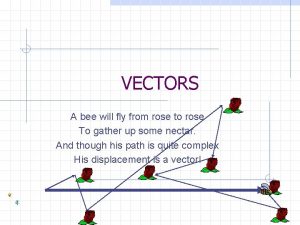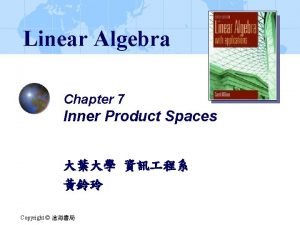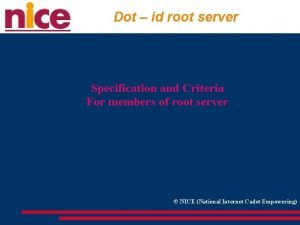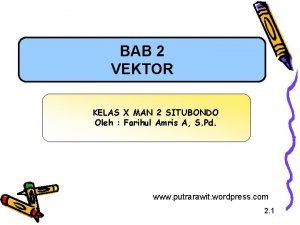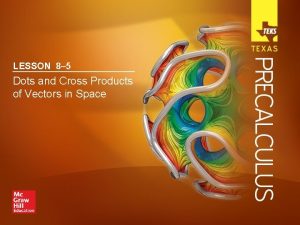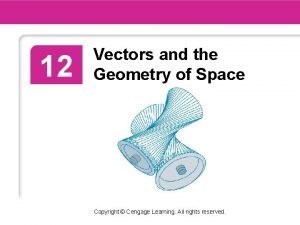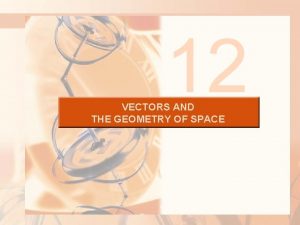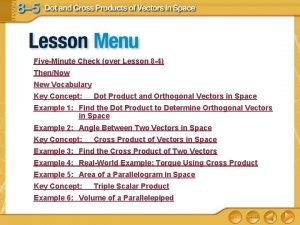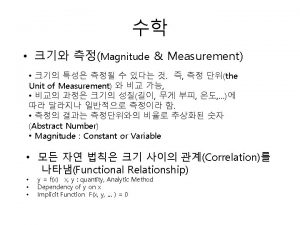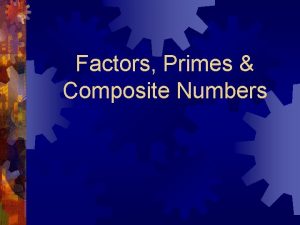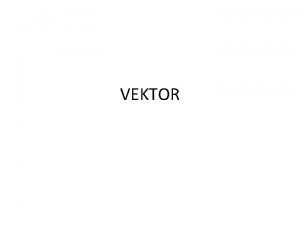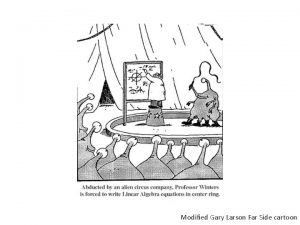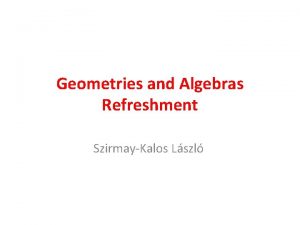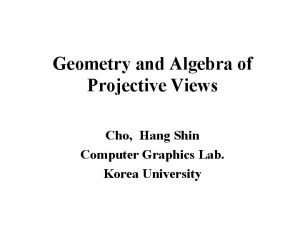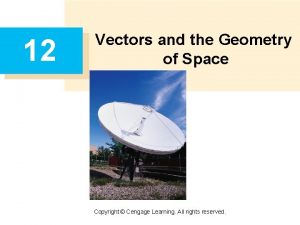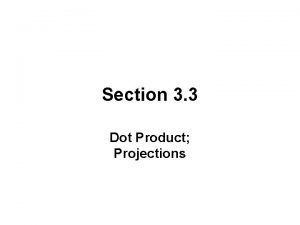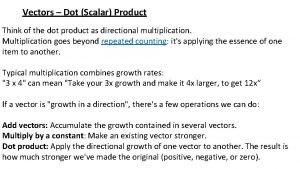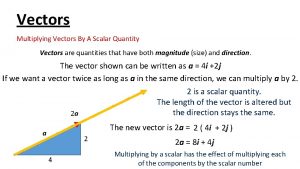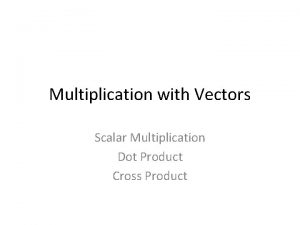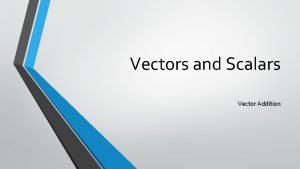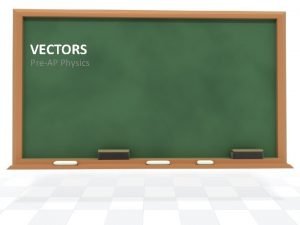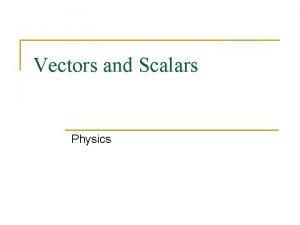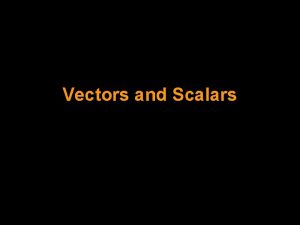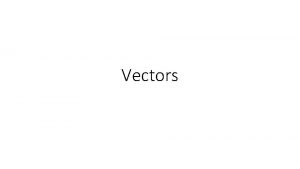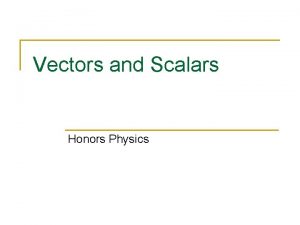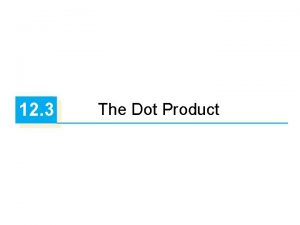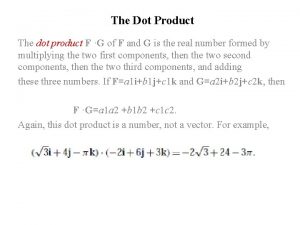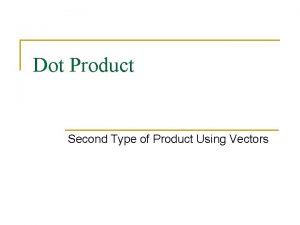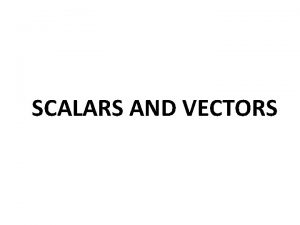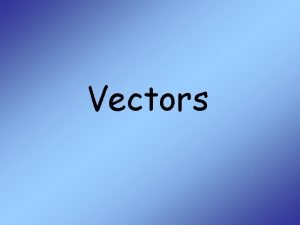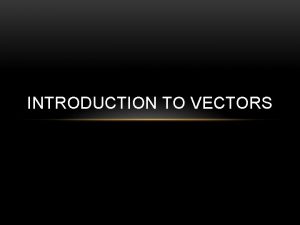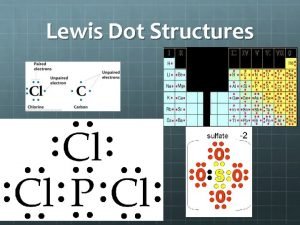T 5 2 Scalar Dot Product of Vectors























- Slides: 23

T 5. 2 - Scalar (Dot) Product of Vectors IB Math SL 1 - Santowski

(A) Review n Operations with Vectors: n (1) Add/subtract (2) multiply by scalar n n (3) HOW do you multiply vectors (if it even means anything in the first place? ? )

(B) Work (Mini physics lesson) n The amount of work done by a force on an object (in physics) depends upon: q q q n (1) the amount of force applied (2) the distance through which the force is applied (displacement) (3) the direction of the applied force relative to the displacement Now, both force and displacement are VECTOR quantities in that both have an associated direction so what does a vector multiplication mean and how do you do it? ?

(B) Work (Mini physics lesson) n Let’s keep things simple if the force applied and the displacement are IN THE SAME direction n I apply a force of 10 Newtons (forward) to move an object 2 meters forward How much work has the force done in moving the box? ? n Diagram

(B) Work (Mini physics lesson) n Let’s keep things simple if the force applied and the displacement are IN THE SAME direction n I apply a force of 10 Newtons (forward) to move an object 2 meters forward How much work has the force done in moving the box? ? 20 joules of work n Diagram

(B) Work (Mini physics lesson) n Let’s make things slightly harder if the force applied and the displacement are IN PERPENDICULAR directions n I apply a force of 10 Newtons (downward) to move an object 2 meters forward How much work does the force do in moving the box? ? n Diagram

(B) Work (Mini physics lesson) n Let’s make things slightly harder if the force applied and the displacement are IN PERPENDICULAR directions n I apply a force of 10 Newtons (downward) to move an object 2 meters forward How much work does the force do in moving the box? ? 0 joules of work n Diagram

(B) Work (Mini physics lesson) n Now things get difficult if there is an angle (0°<θ<90°) between the force applied and the displacement n I apply a force of 10 Newtons (at an angle of θ° to the horizontal) to move an object 2 meters forward How much work has the force done in moving the box? ? n Diagram

(B) Work (Mini physics lesson) n n n I apply a force of 10 Newtons (at an angle of θ to the horiaontal) to move an object 2 meters forward How much work has the force done in moving the box? ? So we need to work with the VECTOR COMPONENTS of our force vector to see HOW MUCH of the 10 N of force actually moves the box forward It turns out that only the horizontal component of 10 cosθ moves the box forward n Diagram 10*cosθ

(B) Work (Mini physics lesson) n I apply a force of 10 Newtons (at an angle of θ to the horiaontal) to move an object 2 meters forward How much work has the force done upon the box? ? n It turns out that only the horizontal component of 10 cosθ moves the box forward n So the work done by the force on the box is (10 cosθ)*(2) or (10)(2)cosθ n Diagram 10*cosθ

(B) Work (Mini physics lesson) Summary n When we deal with vector quantities that are being multiplied (i. e. force and displacement), it is only the components of the two vectors that are in the same direction that matter Hence, the idea of the displacement vector, r, and the horizontal component of the force vector, Fcosθ n So this is how we will understand the multiplication of 2 vectors n Since WORK is a SCALAR quantity (no direction associated with it), we shall use the term SCALAR PRODUCT to describe this one aspect of vector multiplication

(C) Scalar (Dot) Product n So the formula for “multiplying” vectors is n Where the symbol |A| or |B| meam the magnitude of vectors A and B

(C) Scalar (Dot) Product - Examples n (1) How much work is done by a constant force of 50 Newtons when this force is applied at an angle of 60º to pull a 12 meter sliding metal door shut. The diagram shown below illustrates this situation

(C) Scalar (Dot) Product - Examples n (2) A force of 20 Newtons is applied to an object at an angle of -45º with the horizontal. The object is pulled 10 meters at an angle of 25º with the horizontal. How much work is done while moving the object? n (HINT: Draw a diagram)

(C) Scalar (Dot) Product n So the formula for “multiplying” vectors is n But what if the vectors are given in component form? n In general, if u = (ux, uy) and v = (vx, vy) and, the dot product is u∙v = ux vx+ uyvy n The PROOF of this is left up to the STUDENT!!! HAHAH n And then in 3 space, if u = (ux, uy , uz) and v = (vx, vy , vz) and, the dot product is u∙v = ux vx + uyvy + uzvz

Examples n (1) Let v = (2, 5) and u = (– 3, 2) be two 2 dimensional vectors. The dot product of v and u would be ? n (2) Suppose that v = (2, 5) and u = (– 3, 1) as shown in the diagram shown below. We wish to calculate angle, θ, between v and u. n (3) What is the angle between v = (3, – 7) and u = (– 1, 9)?

(C) Scalar (Dot) Product of Perpendicular Vectors & Parallel Vectors n If 2 vectors act perpendicular to each other, the dot product (ie scalar product) of the 2 vectors has value zero. n For the unit vectors i (acting in the x-direction) and j (acting in the y-direction), we have the following dot (ie scalar) products (since they are perpendicular to each other): i • j = j • i = 0

Examples n (4) The dot product of (2, -5, 1) and (-4, -3, -2) is: n (5) Given that a = 3 i – j + 2 k and b = 2 i + j – 2 k, find a • b and the angle between the 2 vectors n (6) http: //dev. physicslab. org/Practice. Problems/Worksheets/Phy 1 Hon/V ectors/dotproduct. aspx n (7) Find the value of t such that the vectors P = 3 i − 5 j and Q = 4 i + t j are perpendicular to each other. n (8) Find the value of m such that the vectors a = 2 mi + mj + 8 k and b = i + 3 mj – k are perpendicular

Examples n (9) Find a vector perpendicular to a = 3 i – 4 j n (10) find a vector perpendicular to both a = 2 i + j – k and b = i + 3 j + k

Properties of the Scalar Product n n (a) Closure NO closure the dot product of 2 vectors is NOT another vector (b) Commutative a · b = b · a (c) Associative NO since (a · b) · c is undefined (d) distributive A · (B+C) = A · B + A · C

Properties of the Scalar Product n (au + bv) · w = (au) · w + (bv) · w, where a and b are scalars n u · v = 0 when u and v are orthogonal. 0· 0=0 |v|2 = v · v a (u·v) = (a u) · v n n n

Internet Links n n n n http: //www. youtube. com/watch? v=WNu. Ih. Xo 39_k http: //hyperphysics. phy-astr. gsu. edu/Hbase/vsca. html http: //www. sparknotes. com/physics/vectormultiplication/s ection 1. html http: //www. netcomuk. co. uk/~jenolive/vect 6. html http: //videolectures. net/mit 801 f 99_lewin_lec 03/ http: //www. intmath. com/Vectors/5_Dot-product-vectors -2 -dimensions. php http: //chortle. ccsu. edu/Vector. Lessons/vch 07_1. html http: //cnx. org/content/m 14513/latest/

Homework n HW : n n Ex 15 H #1 b, 2 a, 3 a, 4 ae, 5 a, 6 a, 8 a, 10 a, 12 c; Ex 16 G #1 be, 4, 7, 9, 11 d, 13; n IB Packet #1, 4, 5, 7
 Scalar product of vectors
Scalar product of vectors Vector dot product
Vector dot product Least square solution
Least square solution Id root
Id root Perkalian cross vektor
Perkalian cross vektor Dot product vs cross product
Dot product vs cross product Perkalian cross vektor i j
Perkalian cross vektor i j 8-5 dot and cross products of vectors in space
8-5 dot and cross products of vectors in space Rumus hasil kali vektor
Rumus hasil kali vektor Scalar triple product properties
Scalar triple product properties Triple product of vectors
Triple product of vectors Cross product of two vectors
Cross product of two vectors Axb
Axb Open dot and closed dot on a graph
Open dot and closed dot on a graph Java vs net
Java vs net Composite numbers definition and examples
Composite numbers definition and examples Panjang vektor
Panjang vektor Dot product
Dot product Dot product intuition
Dot product intuition 2 rr
2 rr Homogeneous coordinates vs cartesian coordinates
Homogeneous coordinates vs cartesian coordinates Dot product
Dot product Find the scalar and vector projections of b onto a.
Find the scalar and vector projections of b onto a. Dot product
Dot product

